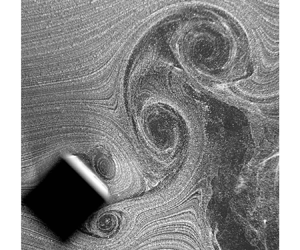Crossref Citations
This article has been cited by the following publications. This list is generated based on data provided by
Crossref.
Benner, Bridget M.
and
Modarres-Sadeghi, Yahya
2021.
Vortex-induced vibrations of a one-degree-of-freedom cylinder transitioning from the inline to the crossflow degree of freedom.
Physical Review Fluids,
Vol. 6,
Issue. 11,
Gurian, Tyler D.
and
Modarres-Sadeghi, Yahya
2021.
Vortex-Induced Vibrations of a square prism free to oscillate in the inline direction.
Journal of Fluids and Structures,
Vol. 102,
Issue. ,
p.
103237.
Patel, Umang N.
Rothstein, Jonathan P.
and
Modarres-Sadeghi, Yahya
2022.
Vortex-induced vibrations of a cylinder in inelastic shear-thinning and shear-thickening fluids.
Journal of Fluid Mechanics,
Vol. 934,
Issue. ,
Mousavisani, Seyedmohammad
Chowdhury, Naumi Noshin
Samsam-Khayani, Hadi
Samandari, Hamed
and
Seyed-Aghazadeh, Banafsheh
2022.
Vortex-induced vibration of a two degree-of-freedom flexibly mounted circular cylinder in the crossflow direction.
Journal of Fluid Mechanics,
Vol. 952,
Issue. ,
Boersma, Pieter R.
Rothstein, Jonathan P.
and
Modarres-Sadeghi, Yahya
2023.
Experimental investigation of vortex-induced vibrations of a flexibly mounted cylinder in a shear-thinning fluid.
Physical Review Fluids,
Vol. 8,
Issue. 4,
Gao, Yue
Liu, Wenli
Zhu, Hongjun
Liu, Hong
Zhou, Tongming
and
Shao, Yongbo
2023.
Experimental investigation on the coupling between the platform motion and the catenary flexible riser response.
Physics of Fluids,
Vol. 35,
Issue. 9,
Chen, Weilin
Alam, Md. Mahbub
Li, Yuzhu
and
Ji, Chunning
2023.
Two-degree-of-freedom flow-induced vibrations of a D-section prism.
Journal of Fluid Mechanics,
Vol. 971,
Issue. ,
Patel, Umang N.
Rothstein, Jonathan P.
and
Modarres-Sadeghi, Yahya
2023.
Forced oscillations of a cylinder in the flow of viscoelastic fluids.
Journal of Fluid Mechanics,
Vol. 975,
Issue. ,
Edraki, Mahdiar
Benner, Bridget
and
Modarres-Sadeghi, Yahya
2023.
Energy extraction from galloping of a prism restricted to oscillate at a fixed magnitude.
Journal of Fluids and Structures,
Vol. 118,
Issue. ,
p.
103840.
Zhao, Yawei
Chen, Weilin
Ji, Chunning
and
Zhang, Zhimeng
2024.
Flow-induced vibrations of an equilateral triangular prism at subcritical Reynolds number.
Physics of Fluids,
Vol. 36,
Issue. 11,
Aye, Yan Naung
and
Srinil, Narakorn
2024.
Numerical Prediction of Two-Dimensional Coupled Galloping and Vortex-Induced Vibration of Square Cylinders Under Symmetric/Asymmetric Flow Orientations.
Journal of Fluids and Structures,
Vol. 131,
Issue. ,
p.
104215.
Patel, Umang N.
Rothstein, Jonathan P.
and
Modarres-Sadeghi, Yahya
2024.
Viscoelasticity in the flow suppresses one- and two-degree-of-freedom vortex-induced vibrations of a cylinder.
Physical Review Fluids,
Vol. 9,
Issue. 11,
Carleton, Adrian
and
Modarres-Sadeghi, Yahya
2024.
Angular vortex-induced vibrations of a cylinder.
Journal of Fluids and Structures,
Vol. 126,
Issue. ,
p.
104087.
Moradi, Mohammad Amin
and
Mojra, Afsaneh
2024.
Free-surface flow past a circular cylinder at high Froude numbers.
Ocean Engineering,
Vol. 295,
Issue. ,
p.
116804.
Carleton, A.G.
and
Modarres-Sadeghi, Y.
2024.
Kirigami sheets in fluid flow.
Extreme Mechanics Letters,
Vol. 71,
Issue. ,
p.
102198.
Liu, Kui
and
Huang, Haibo
2024.
Dynamics of weighted flexible ribbons in a uniform flow.
Journal of Fluid Mechanics,
Vol. 990,
Issue. ,
Pan, Gaochao
Gao, Zhonglin
Zhu, Hongzheng
Yin, Jianqiang
Shi, Qinhui
and
Zhang, Yong
2025.
Effect of non‐ionic frothers on bubble characteristics in flotation: a review.
Journal of Chemical Technology & Biotechnology,
Vol. 100,
Issue. 3,
p.
493.
Rashki, Mohammadreza
Mojtahedi, Alireza
Lotfollahi-Yaghin, Mohammad Ali
Tamimi, Vahid
Dadashzadeh, Mehran
Santos, Paulo Rosa
Bernitsas, Michael M.
and
Srinil, Narakorn
2025.
A review of two-degree-of-freedom vortex-induced vibrations with hydrokinetic energy harvesting applications.
Ocean Engineering,
Vol. 321,
Issue. ,
p.
120376.
Benner, Bridget M.
Carleton, Adrian G.
and
Modarres-Sadeghi, Yahya
2025.
Transition from vortex-induced vibrations to galloping in a flexible square prism.
Journal of Fluid Mechanics,
Vol. 1007,
Issue. ,

 $\alpha = 45^{\circ }$ corresponds to the case where one of the edges of the prism sees the flow first), we observe a two degree of freedom vortex-induced vibration (VIV) response with a figure-eight trajectory, similar to what has been observed for a cylinder with two degrees of freedom. As the angle of attack is decreased, the figure-eight trajectory transitions to a teardrop trajectory, suggesting a
$\alpha = 45^{\circ }$ corresponds to the case where one of the edges of the prism sees the flow first), we observe a two degree of freedom vortex-induced vibration (VIV) response with a figure-eight trajectory, similar to what has been observed for a cylinder with two degrees of freedom. As the angle of attack is decreased, the figure-eight trajectory transitions to a teardrop trajectory, suggesting a  $1:1$ ratio between the oscillation frequencies in the CF and IL directions. The VIV response remains to be the dominant response down to an angle of attack of
$1:1$ ratio between the oscillation frequencies in the CF and IL directions. The VIV response remains to be the dominant response down to an angle of attack of  $\alpha = 20^{\circ }$. At angles of attack of
$\alpha = 20^{\circ }$. At angles of attack of  $\alpha = 10^{\circ }$ and
$\alpha = 10^{\circ }$ and  $\alpha = 15^{\circ }$, the VIV response becomes negligible and elliptical trajectories are observed at higher reduced velocities. These elliptical trajectories then become four-lobe trajectories with amplitudes mainly in the CF direction at the lowest angles of attack (where a side of the square sees the flow first) and galloping-type response is observed, where the amplitude of oscillations is increased with increasing reduced velocity. Deviations from a typical galloping response are observed due to synchronizations between the shedding frequency and oscillation frequency at ranges of higher reduced velocities.
$\alpha = 15^{\circ }$, the VIV response becomes negligible and elliptical trajectories are observed at higher reduced velocities. These elliptical trajectories then become four-lobe trajectories with amplitudes mainly in the CF direction at the lowest angles of attack (where a side of the square sees the flow first) and galloping-type response is observed, where the amplitude of oscillations is increased with increasing reduced velocity. Deviations from a typical galloping response are observed due to synchronizations between the shedding frequency and oscillation frequency at ranges of higher reduced velocities.